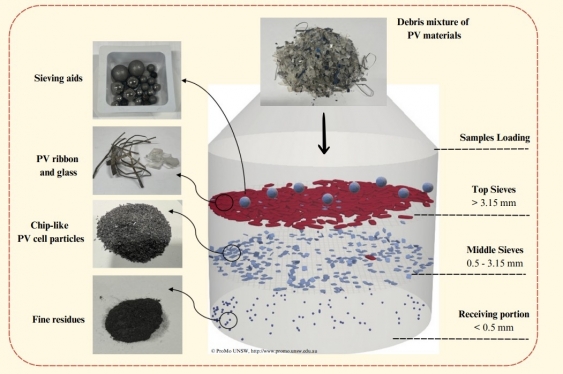Scientists at an Australian university have patented a new technique for recycling end-of-life photovoltaic (PV) panels, saying it separates 99% of PV cell particles.
The International Renewable Energy Agency estimates that eight million tonnes of PV waste will have been produced globally by 2030 as the panels come to the end of their life. That figure is expected to rise to 78 million tonnes by 2050. Recycling panels thoroughly is difficult because the individual parts such as glass, silicon, metals, wiring and plastic are integrated in such a way that makes them hard to separate.
The patented sieving process developed by the ProMO lab at UNSW Sydney has been specially created for PV panels to quickly and efficiently sort the component materials. The first typical step to recycle PV panels involves the removal of large components such as the aluminium frame and glass sheets to just leave the solar cell.
Bottleneck
The ProMo team is led by Yansong Shen who says the crushing the panel and separation of material inside the solar cell is currently one of key bottlenecks.
‘If we do not have a simple method for high-abrasion separation, then we can’t effectively move on to the third step which is recovering the various material that has been separated and being able to reuse it,’ he explains. ‘The key to our new process is the addition of the sieving aids which help to crush the solar cells into smaller particles allowing a better separation of all the components. That makes it much easier to recover important elements such as the silver contained in the solar cells.’

The entire crushing and sieving process, which occurs inside a vibrating container, takes up to 15 minutes to effectively separate the PV materials. In tests, using their process, the researchers were able to extract 99% of silver from a cell for potential reuse.
Feasibility
‘Our group of 30 researchers is the largest in Australia working on PV recycling technology development, not lifecycle assessment only, and probably one of the largest in the world. This patent is just one part of one recycling process for end-of-life solar panels and we are also working on other solutions to the other steps,’ says Shen.
‘We are working with some industry partners but we would like to engage in more industry collaborations to scale this process up and enhance the economic feasibility of the PV recycling process.’
Don't hesitate to contact us to share your input and ideas. Subscribe to the magazine or (free) newsletter.


